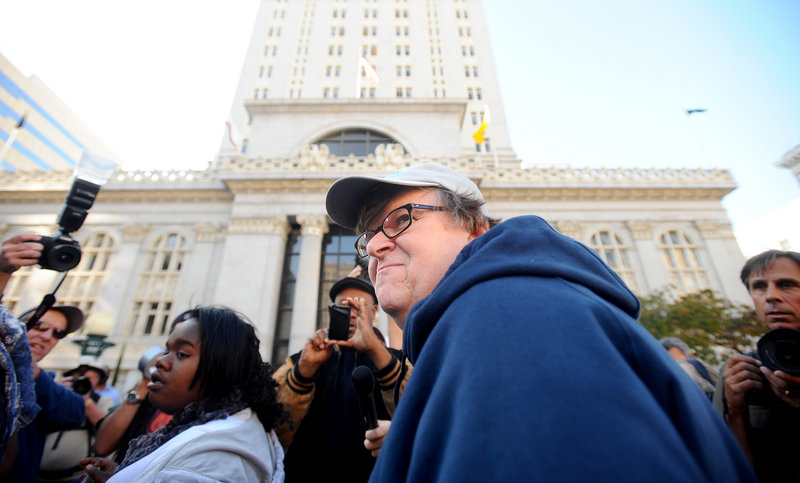OAKLAND, Calif. – What began as just another anti-Wall Street protest “occupation” in a mid-size California city has grown into a global phenomenon and turned Oakland into an epicenter of the Occupy Wall Street movement.
Sparked by the injury Tuesday night of 24-year-old Iraq war veteran and ex-Marine Scott Olsen, the Occupy Oakland movement almost overnight became an international symbol of resistance around which millions of people are now rallying.
The latest sign of Oakland’s galvanizing effect came Friday afternoon with the anticipated arrival of Michael Moore — and his 912,898 and counting Twitter followers — to the amphitheater of Frank Ogawa Plaza, where it all began.
In cities across the country, thousands of protesters Thursday night expressed their solidarity with Olsen — and by extension the city of Oakland — by chanting and holding signs that said: “We are all Scott Olsen.”
As the Occupy Wall Street movement continues to evolve, it is quickly becoming clear that Oakland is at the vanguard.
“At a certain point, we have to overcome the fear that so many of us are feeling,” said Josh Chavanne, a 29-year old Web designer and Oakland native. “This is our chance to make history.”
The world is indeed paying attention. On Friday morning White House press secretary Jay Carney addressed the violence that led to Olsen’s injury.
“I know that (Obama) is aware of it,” Carney said when asked whether the president knew about Olsen’s condition. “As I said yesterday, it’s very important that we remember that we have a long and noble tradition of free expression, free speech and protests and demonstrations in this country.”
But in newsrooms, bars, homes and other protest sites around the world, the tenor and mood of the Oakland protest continues to captivate imaginations and spark questions about where the movement is headed next.
MSNBC’s Keith Olbermann and comedian Jon Stewart chimed in immediately. Olbermann called for Oakland Mayor Jean Quan’s resignation, while Stewart showed footage of police in riot gear tossing canisters of tear gas into crowds of screaming protesters. “What happened in Oakland?” he quipped.
In Washington, the online news magazine Politico asked whether Olsen’s injuries in Oakland would become “a Kent State moment” and referred to a comment made two weeks earlier by an MSNBC commentator who speculated that the movement might soon see “a climax moment of class warfare somehow played out on screen.”
That moment may have come.
In Cairo, an Egyptian journalist, human rights activist and veterinarian named Mohammed Maree tweeted a picture of a protester carrying a sign that said, “From Tahrir to OccupyOakland and USA, one case, one goal, social justice for all.” In a remarkable display of how Oakland’s unique personality has infiltrated the larger conversation, the tweet ended with this: “(Expletive) the Police.”
Meanwhile, protesters in Philadelphia marched to the statue of former Mayor Frank Rizzo in support of Oakland’s aims. The Philadelphia protesters have also joined ranks to support another innovation that originated with the Oakland protesters: a general strike planned for Wednesday.
Several unions, including a prominent teachers union and the local longshoremen’s union, said Friday they wouldn’t take part in the general strike but are encouraging members to support the movement.
Whatever happens with the strike, however, a view is taking shape that while New York was the genesis of the movement, Oakland has become, as one Oakland resident tweeted, the “front line of the revolution.”
From the very beginning, in fact, the protesters in Oakland had set their sights high. They organized and planned for a full week before setting up their camp in the plaza.
Once there, they made a point of trying to serve the needs of residents they felt the city had largely neglected — mostly the poor and homeless. But it was also about more than that.
“This is a base camp for a lot of different struggles,” said 65-year-old John Reimann, a retired Oakland carpenter and longtime union organizer who helped call for the general strike last week.
Now, that sense of collective purpose is continuing to draw in people from many different sectors of society.
“There’s a radicalism in Oakland, the working people, they’re not coming to protest and then going home to watch themselves on the news; that makes it special,” said Harry Brass, 71, a self-described former radical from Berkeley, Calif. “If it stays like this, it could be the leader, Oakland could take over from New York.”
Send questions/comments to the editors.




Success. Please wait for the page to reload. If the page does not reload within 5 seconds, please refresh the page.
Enter your email and password to access comments.
Hi, to comment on stories you must . This profile is in addition to your subscription and website login.
Already have a commenting profile? .
Invalid username/password.
Please check your email to confirm and complete your registration.
Only subscribers are eligible to post comments. Please subscribe or login first for digital access. Here’s why.
Use the form below to reset your password. When you've submitted your account email, we will send an email with a reset code.